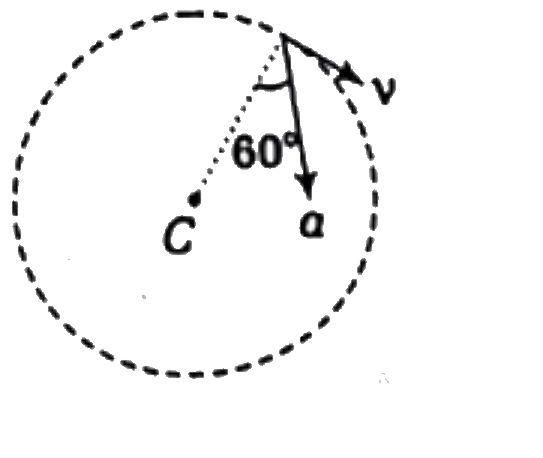A particle moves in a circle of radius 25 cm at 2 revolution per second. The acceleration of the particle in meter per second2 is
π2
8π2
4π2
2π2
To find the acceleration of a particle moving in a circle, we can follow these steps:
Step 1: Convert the radius from centimeters to meters
The radius of the circle is given as 25 cm. We need to convert this to meters.
r=25cm=25×10−2m=0.25m
Step 2: Determine the frequency of rotation
The particle rotates at a frequency of 2 revolutions per second.
n=2rev/s
Step 3: Calculate the angular velocity
The angular velocity (ω) can be calculated using the formula:
ω=2πn
Substituting the value of n:
ω=2π×2=4πrad/s
Step 4: Calculate the centripetal acceleration
The centripetal acceleration (a) for a particle moving in a circle can be calculated using the formula:
a=ω2r
Now, substituting the values of ω and r:
a=(4π)2×0.25
Calculating (4π)2:
(4π)2=16π2
Now substituting back into the equation for acceleration:
a=16π2×0.25=4π2m/s2
Final Answer
The acceleration of the particle is:
a≈39.478m/s2(using π≈3.14)
The radius of the circle is given as 25 cm. We need to convert this to meters.
The particle rotates at a frequency of 2 revolutions per second.
The angular velocity (ω) can be calculated using the formula:
The centripetal acceleration (a) for a particle moving in a circle can be calculated using the formula:
The acceleration of the particle is:
Topper's Solved these Questions
- SELF ASSESSMENT PAPER 02BOOK - ICSECHAPTER - SELF ASSESSMENT PAPER 02EXERCISE - SECTION - A(Answer the following )
7 Videos
- SELF ASSESSMENT PAPER 02BOOK - ICSECHAPTER - SELF ASSESSMENT PAPER 02EXERCISE - SECTION-B (Answer the following )
13 Videos
- SELF ASSESSMENT PAPER 01BOOK - ICSECHAPTER - SELF ASSESSMENT PAPER 01EXERCISE - SECION- D (Answer the following )
6 Videos
- SELF ASSESSMENT PAPER 3BOOK - ICSECHAPTER - SELF ASSESSMENT PAPER 3EXERCISE - Section-D
6 Videos
Similar Questions
A particle moves in a circle of radius 5 cm with constant speed and time period 0.2πs. The acceleration of the particle is
View SolutionIf a particle moves in a circle of radius of 4m at speed given by v=2t where v is in m/s and t in sec.At t=4s ,net accleration of particle will be:
View SolutionA particle moves in a circle of radius 1 cm at a speed given v=2t, where v is cm/s and t is in seconds. Total acceleration of the particle at t=1 second is 2√ncm/s2. Find value of n.
View SolutionA particle moves along a circle of radius r with constant tangential acceleration. If the velocity of the particle is v at the end of second revolution, after the revolution has started, then the tangential acceleration is
View SolutionA particle moves in a circle of radius 20 cm. Its linear speed is given by v=2t, where t is in second and v in metre/ second. Find the radial and tangential acceleration at t=3s.
View SolutionThe figure shows the total acceleration a=32ms−2 of a moving particle moving clockwise in a circle of radius R = 1 m . What are the centripetal acceleration a and speed of the particle at the given instant ?

View SolutionA particle is moving in a circle of radius 23m and mass of the particle is 2kg. The kinetic energy of the particle dependes on distance 'S' travelled by the particle as K.E. = 4S4. The angle made by net acceleration with the radial acceleration when the particle rotate by 60∘ is
View SolutionA merry go round has a radius 4 m and completes a revolution in 2 seconds. Then acceleration of a point on its rim is
View SolutionA charge q coulomb moves in a circle at n revolution per second and the radius of the circle is r metre. Then magnetic feild at the centre of the circle is
View SolutionA charge of 10−6C is describing a circular path of radius 1cm making 5 revolution per second. The magnetic induction field at the centre of the circle is
View Solution
